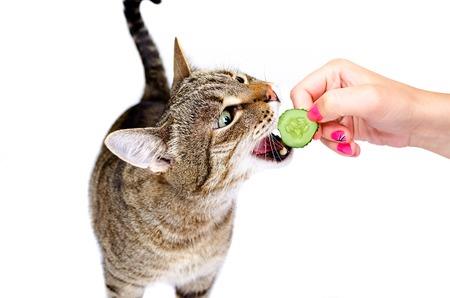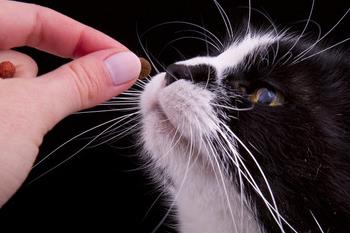The largest motivation in animal training, no doubt, is food. Food rewards have achieved seemingly impossible results—teaching pigeons to play table tennis, crows to pick locks using tools, and cats to come when called.
It is no secret that cats are less responsive to rewards for learning dubious tasks, which is understandable, if you consider their hunting methods—their natural diet consists of small meals and they dismiss as inefficient needing to perform overly complex tasks to get rewards.
However, you can train a cat to perform complex tasks if you have the right bait and you know the right technique. In this article, you are going to learn about the best treats to use for cat training and several tips to make it more successful.
Features to look for in cat training treats
Whenever you are training a cat, or any other animal, the more precisely you can point to a desired action or behavior, the faster the training will proceed.

Cucumber obviously isn’t the best choice for a training treat
Therefore, training rewards must have some crucial features. They must be easy to carry around and issue, fast to consume, and preferably, irresistibly delicious and aromatic.
Whenever your cat performs a desired action, you must reach into your pocket and give the cat a treat within few seconds. A little too late, and it is too late for the cat to associate it with the task. A clicker can be useful in certain situations, as it can help pinpoint the precise fraction of correct action without the distraction of reaching for a treat. You can learn more about clicker training for cats here.
It also means that, usually for training good behavior, you must have treats within arm’s length most of the time. A treat bag is ideal for the purpose, but it’s a mess if treats are moist or if they spoil at room temperature.
Last, but likely most important, the treat must be delicious. In many cases, when a task is complex, it must be extremely delicious; let it be said that a cat must not look for motivation, motivation must find the cat.
What treats are best to use in cat training
There is no one best treat, because it depends on several things—what your cat prefers, what task you want your cat to learn, how often you must reward your cat, etc. Let’s review your options.
- Commercial cat treats. There are two kinds—semi-moist and dry. Most are small pieces that can be carried in a treat bag, keeping your hands (almost) clean. Treats are available in different flavors and usually are more palatable than regular everyday food. Additionally, most treats are low in calories, which is good if you want to train your cat a lot. However, they can be unhealthy, although “healthier” varieties are on the market, too. In general, if treats do not exceed 10 percent of total caloric intake, you shouldn’t worry about their impact on your cat’s nutrition. However, for small animals, such as cats, 10 percent can add up rather quickly.

- Your cat’s normal dry food. If you feed your cat dry kibble, it’s also appropriate for most training needs, though it can be less preferred and less motivating than flavored training treats. However, kibble is very convenient and available at home at all times. You do not need to count how many calories your cat gets through treats or subtract it from total daily intake. Just measure your cat’s daily food in a cup and feed as you see fit—part as meals, part as training treats, or even all as training treats. If you need to reward your cat a lot, choose a low-calorie cat food.
- Canned food. Tuna or canned cat food provides two extremes. They are usually very aromatic, thus motivating, but are also a hassle to use. They are poor choices for training that requires fast and frequent repetitions, such as training a cat to sit. However, to build trust or eliminate fear, canned food might be the best choice because of its taste.
- Raw and cooked meat. This is an obvious choice for people who feed their cats homemade and raw diets, as they also want to incorporate the same healthy diet in their cat’s training. Don’t overthink it though; I think you can easily use a less-healthy alternative in training without remorse, if you use it as intended—treats in small quantities. If you need to, you can use chunks of meat or organs that can be swallowed easily, such as muscle meat, heart, or liver. Chicken meat is the easiest choice, because it’s light, affordable, and accessible, but don’t feel limited—any human-grade meat will do. Cut the meat into pieces as small as practical, so you can give more for the same amount of calories. For your convenience, moderately cook or boil the pieces, so they are firm on the outside, but don ‘t make them dry.
If you find that your cat is reluctant to take food rewards, you can try skipping a meal so the food will motivate it more; however, do not starve it. As I’ve said before, there’s no universal reason why one treat is better than another. The best strategy is to try different types, different brands, and different flavors to see what works the best for you and your cat.
